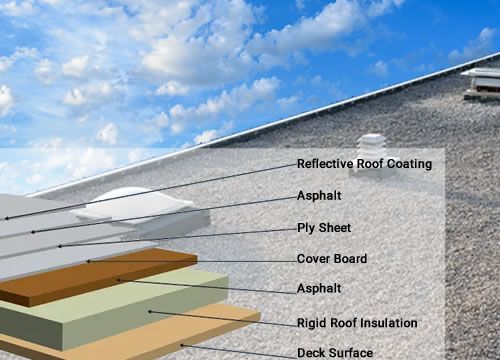Built-Up Roofing (BUR): A Detailed Analysis

Built-Up Roofing (BUR): A Detailed Analysis
Built-Up Roofing (BUR), commonly known as tar and gravel roofing, has been a preferred commercial roofing option for more than a century. It is characterized by multiple layers of asphalt and reinforcing materials, providing outstanding waterproofing capabilities and durability.
Composition and Installation
BUR systems are created through alternating layers of reinforcing fabrics and bitumen (asphalt), finished with a surface aggregate like gravel or crushed stone.
Layers in BUR Systems
Base Sheet: The initial layer attached to the roof deck, providing foundational protection.
Interply Sheets: Typically asphalt-impregnated felt, applied between asphalt layers to add strength.
Bitumen Layers: Asphalt or coal tar, applied hot, providing waterproofing and adhesion.
Surfacing: Gravel or aggregate layer providing protection against UV rays, weathering, and foot traffic.
Advantages of Built-Up Roofing
BUR systems offer several compelling advantages for commercial roofing projects:
Longevity: Properly installed and maintained BUR systems can last upwards of 30 years.
Waterproof Integrity: The multiple-layer design ensures superior resistance to water penetration.
Fire Resistance: BUR systems, particularly with gravel surfaces, exhibit excellent fire-resistant properties.
Enhanced Durability: Resistant to impact, foot traffic, and mechanical damage due to the rugged surface.
Thermal Performance: Provides exceptional insulation qualities, helping regulate indoor temperatures and energy costs.
Challenges of Built-Up Roofing
Despite numerous advantages, BUR systems come with certain challenges:
Installation Complexity: Requires skilled labor for proper installation due to hot asphalt application.
Heavy Weight: The multiple layers result in substantial weight, requiring structural assessments.
Maintenance Requirements: Regular maintenance and inspections are crucial to prolonging lifespan and ensuring waterproof integrity.
Maintenance Practices for BUR
Consistent maintenance significantly extends the life of BUR systems:
Regular Inspections: Conduct detailed assessments at least twice a year and after extreme weather events.
Surface Maintenance: Ensure gravel or aggregate remains evenly distributed, replenishing as necessary.
Debris Removal: Routine clearing of leaves, branches, and other debris prevents damage and water accumulation.
Prompt Repairs: Immediate attention to blisters, cracks, or damaged sections prevents larger issues.
Selecting the Right BUR System
When considering a BUR system, several factors should guide your decision:
Structural Considerations: Ensure your building's structure can support the added weight.
Environmental Impact: Consider local climate conditions, temperature fluctuations, and exposure to UV radiation.
Budgeting and Longevity: Balance the higher initial installation costs against the extended lifespan and minimal repair expenses.
Conclusion
Built-Up Roofing provides exceptional durability, longevity, and waterproofing for commercial buildings. By understanding the detailed composition, advantages, and maintenance needs, commercial property owners can optimize their investment, ensuring a robust, cost-effective roofing solution that meets their long-term structural and operational needs.
Be sure to check out our article about every kind of commercial roofing here: Commercial Roofing Systems Overview: A Comprehensive Guide - Roofing Tools Online
